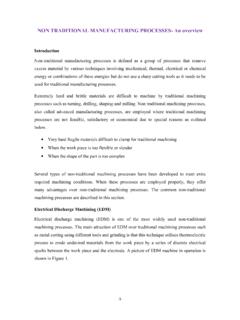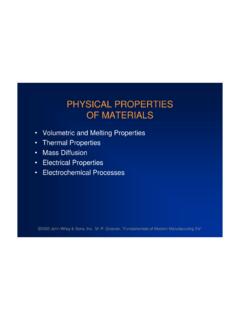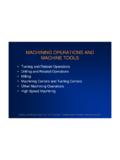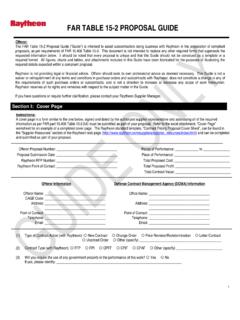Transcription of DIY Machining - GRBL Settings - Pocket Guide
1 Command $$$0=10 $1=25 $2=0 Setting ValueReverse XReverse YReverse ZSetting ValueReverse XReverse Y0 NONONO4 NONO1 YESNONO5 YESNO2 NOYESNO6 NOYES3 YESYESNO7 YESYES$3=6 $4=0 $5=0 $6=0 Value124816$11= $12= $13=0 $20=0 $21=0 $22=0 $23=1 This refers to the probe pins which by default are set to high using the Arduino's internal pull up resistors. Grounding the pin tells GRBL the probe is tripped. For the opposite behavior use the setting $6=1 which tells the system that a high is the probe trigger. You must also install external pull down resistor with the $6=1 setting. Think of this as cornering speed. A high values allows for fast motion around corners but increases the risk of missed steps resulting in decreased accuracy. Conversely, lower values reduce the speed around a corner decreasing the risk of missing steps while potentially improving accuracy.
2 GRBL treats curves as a collection of small straight lines. This setting defines how smooth the curves will be. The default is .002mm and will not likely need to be changed as this value is below the accuracy of most Machining - GRBL Settings - Pocket GuideThe following Settings are specific to GRBL - For more information visit current GRBL Settings stored in EEPROM (memory) of the ArduinoStep Pulse ConfigurationAxis DirectionStep Enable InvertLimit Pins InvertProbe Pin InvertDefinitionView SettingsStep Pulse Length ( sec)Step Idle Delay (msec) $10=3 Status ReportJunction Deviation (mm)Arc Tolerance (mm)This sets the length of the step pulse delivered to the stepper motors. The goal is to have the shortest step pulse your motors can reliably recognize. The data is available on some stepper motor data sheets otherwise 10 is a good default.
3 Sets the time delay in milliseconds that GRBL will power the stepper motors after a motion command is complete. A setting of 255 tells the motors to stay powered on to hold position. Defines the step signal sent to the stepper motor drivers. By default the step signal starts low and goes high to denote a step pulse event. See Axis Config. Table axis motion direction without changing wiring. See Axis Config. Table the signal sent to the enable pin of your stepper drivers. $4=1 sets the enable pin to high. (Invert)This refers to the limit switch pins which by default are set to high using the Arduino's internal pull up resistors. Grounding the pin tells GRBL the limit switch is tripped. For the opposite behavior use the setting $5=1 which tells the system that a high is the limit switch trigger. You must also install external pull down resistor with the $5=1 setting.
4 Reverse ZYESYESYESA llows the user to change the direction of the homing cycle us the values from the Axis Config. Table on page UnitsSoft Limits (Enable/Disable)Hard Limits (Enable/Disable)Homing Cycle (Enable/Disable)Homing Cycle DirectionDefines the real time data sent to the user. By default GRBL reports running state which cannot be turned off, machine position & work position. The table to the right details the Settings . Note to send a combination of status reports, simply add the values of the desired report types and send this value to GRBL. For Example, say I want Work Position (2) & Limits (16), I would send $10=18. Report TypeMachine PositionWork PositionPlanner BufferSets position feedback units from mm to inches. $13=1 for inches or $13=0 for mmRequires "Homing" be enabled and checks to see if gCode commands will exceed the travel limits of the machine.
5 $20=1 Enable $20=0 DisableRequires limit switches be installed and looks for one of the limit switches to be activated which triggers "Alarm" mode. In this mode, all machine motion, the spindle and coolant are shutdown. Requires limit switches be installed. Enabling this will lock out all gCode commands until a "Homing" cycle is BufferLimit PinsFor more information visit ExplanationDefinition$24= $25= $26=250 $27= $100= $101= $102= $110= $111= $112= $120= $121= $122= $130= $131= $132= $# $G $I $N $N0=line$N1=line $x=value $C $X $H ~ ! ? ctrl-x Feed rate used in the "Homing" cycle once the limit switches are located. The lower the value the more repeatable the zero - Max Acceleration (mm/sec2)X - Max Travel (mm)Y - Max Travel (mm)Y (steps/mm)Z (steps/mm)X - Max Rate (mm/min)Y - Max Rate (mm/min)X - Max Acceleration (mm/sec2)Y - Max Acceleration (mm/sec2)Homing Feed (mm/min)Homing Seek (mm/min)Homing Debounce (msec)Homing Pull-off (mm)X (steps/mm)Save GRBL SettingSave Startup BlockCheck gCode ModeZ - Max Travel (mm)Z - Max Rate (mm/min)View gCode ParameterView Parser StateView Build InfoTells the machine how far to move away from the limit switches after finding the "Home" position so as not to trigger the hard GRBL how many steps are required to move the machine a given distance.
6 Steps/mm = (Steps per Revolution)*(Microsteps) / (mm per Revolution) 1) Steps per Revolution = 200 Typical - This is the number of steps required for your stepper motor to make 1 complete revolution. 2) Microsteps - 1,2,4,8,16 - Is a setting on your stepper motor driver. A higher value means lower torque but higher accuracy. 3) mm per Revolution - Determined by your machine setup. (lead screw pitch)Defines the maximum speed for a given axis. This is found experimentally for each axis by incrementally increasing the value and then sending a test gCode command to move the axis. Be sure the command allows the axis to move enough to reach the maximum rate. You will know the maximum speed when the stepper motors stalls. Reduce the value by 10-20% These values may be different for each the maximum acceleration for a given axis.
7 This is found experimentally for each axis by incrementally increasing the value and then sending a test gCode command to move the axis. Be sure the command allows the axis to move enough to reach constant motion. If you decide to use a jog command make sure the jog increment is several inches. You will know the maximum value when the stepper motors stalls. Reduce the value by 10-20% These values may be different for each when soft limits are enable to tell GRBL the maximum travel for each axis. This also requires the use of a homing rate used in the "Homing" cycle to locate the limit switches. Set this to the highest value that does not cause the machine to crash into the limit switches. Length of the software delay in milliseconds that minimizes switch noise. A value between 5 an 25 is buffered gCode commands. Used to resume cutting after a "Feed Hold.
8 "Stops active cycle by controlled deceleration preventing position lose from missed steps. Returns the active GRBL state & current machine & work reset command retains machine position without powering down the CommandsReal Time GRBL CommandsDisplays the startup blocks run each time GRBL is powered on or used to save a GRBL setting. Replace the "X" with a number from the list above and the "value" with the corresponding used to save startup blocks. Substitute valid gCode commands for the "line" portion and these will executed each time GRBL is powered on or all incoming gCode commands but does not move the axis, spindle or coolant so the user can check a gCode the alarm lock to allow for axis the homing StartFeed HoldCurrent StatusReset GRBLKill Alarm LockRun Homing CycleLists work coordinate offsets (G54-G59), Predefined positions (G28 & G30), Coordinate offset (G92), Tool Length Offset (TLO) & Probing cycle (PRB).
9 Displays the active gCode modes in the GRBL parser. Example - [G0 G54 G17 G21 G90 G94 M0 M5 M9 T0 ]Shows the GRBL version and source code build Startup BlocksFor more information visit



